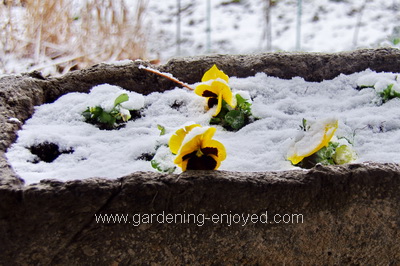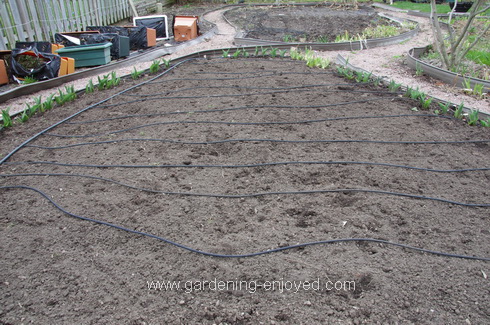| Back to Back Issues Page |
 |
|
Dallying In The Dirt, Issue #286 - Last fall we planted Crocus in the lawn and we are being rewarded April 12, 2017 |
 Last week I showed you the flat of Pansies that I had purchased and suggested that it might be too early. I planted them. It snowed. Many of my friends and neighbours think I cause the late snowfalls by planting Pansies. There does seem to be some correlation many years. It’s never a problem to the Pansies. I water them with some lukewarm water. That melts the snow and thaws out the slightly frozen soil and the Pansies carry on as if nothing had happened. Three days later they all have bright yellow blooms on them and are growing happily. The squirrel that dug up a few of them does much more damage than a few centimeters of snow. I had my partial revenge this morning as one of those bushy tailed tree rats went into the trap after the peanuts and I was able to take him, maybe her I can’t tell, on a short road trip. The Assistant Gardener suggests that I should have a can of orange spray paint to put a small patch on their tails to see if they make their way back
here. They have to cross a double train track and a 6 lane highway to do so but these are squirrels were talking about.
Last week I showed you the flat of Pansies that I had purchased and suggested that it might be too early. I planted them. It snowed. Many of my friends and neighbours think I cause the late snowfalls by planting Pansies. There does seem to be some correlation many years. It’s never a problem to the Pansies. I water them with some lukewarm water. That melts the snow and thaws out the slightly frozen soil and the Pansies carry on as if nothing had happened. Three days later they all have bright yellow blooms on them and are growing happily. The squirrel that dug up a few of them does much more damage than a few centimeters of snow. I had my partial revenge this morning as one of those bushy tailed tree rats went into the trap after the peanuts and I was able to take him, maybe her I can’t tell, on a short road trip. The Assistant Gardener suggests that I should have a can of orange spray paint to put a small patch on their tails to see if they make their way back
here. They have to cross a double train track and a 6 lane highway to do so but these are squirrels were talking about.  The outside gardens are filling up with wonderful things making me want to spend as much time out their as possible but in the kitchen is the result of some of last summer’s efforts. These Phalaenopsis Orchids summer outside in the shade and that seems to successfully prompt them into bloom by late winter. The purple one in the centre is new but the others are rebloomers from previous years. The yellow one seems to have picked up a few hitchhikers over the summer. They summer on a set of shelves that also have several pots of Fibrous Begonias and apparently those Begonias shed a few seeds. I keep thinking I should try and separate them but they seem happy together and I would probably kill one or both by trying to be kind to them. The last of the Christmas Amaryllis can be seen throwing a late flower bud between the white Orchid blooms. This many
flowers in the kitchen seems to find favour with the Assistant Gardener.
The outside gardens are filling up with wonderful things making me want to spend as much time out their as possible but in the kitchen is the result of some of last summer’s efforts. These Phalaenopsis Orchids summer outside in the shade and that seems to successfully prompt them into bloom by late winter. The purple one in the centre is new but the others are rebloomers from previous years. The yellow one seems to have picked up a few hitchhikers over the summer. They summer on a set of shelves that also have several pots of Fibrous Begonias and apparently those Begonias shed a few seeds. I keep thinking I should try and separate them but they seem happy together and I would probably kill one or both by trying to be kind to them. The last of the Christmas Amaryllis can be seen throwing a late flower bud between the white Orchid blooms. This many
flowers in the kitchen seems to find favour with the Assistant Gardener.Now it’s time to answer a few of my reader’s questions. To ask a question just “reply” to this ezine. Don’t forget to check the front page of the Website for frequent short ideas for current gardening activities. Judy Asks? Hope you can help me with my disgusting front lawn which is completely dead. Two years ago the town did road/sewer work digging up 2/3 of our front lawn as well as all the neighbors on this side of our road. Contractors spread soil in the fall that was heavily contaminated with weeds, then took winter off. We were apparently forgotten and by June of the next year, those weeds grew to 3 ft tall. Yes, I did contact those responsible, and as spokesperson for neighbors, finally got action. Contractors cut the weeds, churned up the soil and hydro seeded all of our lawns. We watered
faithfully, paid our water bills and waited. And waited, and waited. A few tufts of grass and of course those hardy returning weeds does not a lawn make. So I'm back on the Township, County, Contractors again, adding council meeting this time. Finally, contractor removed weedy soil, spread new topsoil, sodded and watered it for 2 weeks to save us water bill expenses. Phew what a battle! We finally had the beautiful lawns we started with! Then the summer drought of 2016 and sever watering restrictions blew it all apart. As a result all those beautiful front lawns are now dead, not sleeping, dead. No roots, and soil is blowing in the wind. Of course, a few weeds are greening up though. Question: what is my best recourse? Re-sew, Re-sod, Retreat, Plant white clover, Paint it green?? Can't be certain that the rains will come this year either. It's so ugly out there. |
| Back to Back Issues Page |
